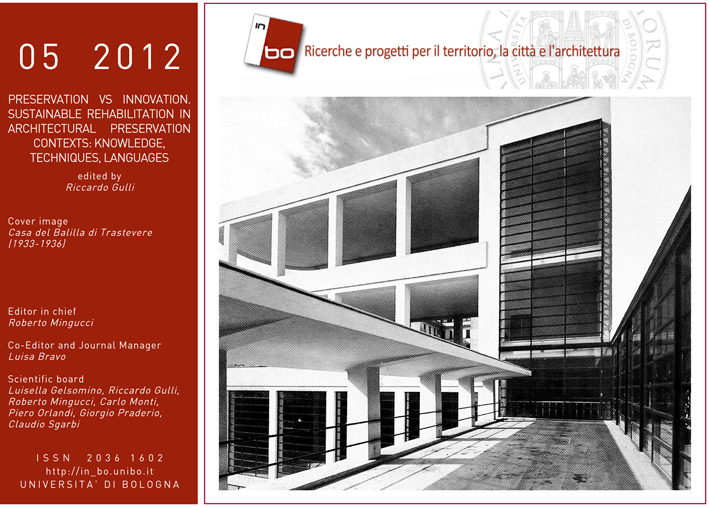From energy retrofitting to sustainable renovation. An energy analysis of compact urban fabrics
DOI:
https://doi.org/10.6092/issn.2036-1602/3477Keywords:
urban density and form, Mediterranean compact city, urban fabric, energy performance, building stockAbstract
Recent studies point out the importance of urban areas, in spite of the ever increasing unsustainable nature of the conventional city. In the specific context of the Mediterranean compact city, new settlement models are still a negligible proportion compared to the great mass of the ordinary city. Find operative way to transform the existing building stock, became more crucial than imagine a new one much more energy-efficient. Hence, seems necessary to deal with the existing urban fabrics in order to define more sustainable condition. The results here proposed of a comparative study carried out on various urban fabrics, in search of parametric relations between density and energy performance. Such methodology can represent a knowledge-base and lead to conscious and effective urban transformations, towards more efficient conditions.
References
AA. VV. (2011), Attuazione della certificazione energetica degli edifici in Italia, translated by CTI and MCE, Milano
Alexander Ernest R.(1993), Density measures: A review and analysis, Journal of Architectural and Planning Research, 10(3), pp.181-202
Breheny Michael (1996) Centrists, decentrists and compromisers: views on the future of urban form, in Jenks, M., Burton, E. and Williams, K., eds., The Compact City. A Sustainable Urban Form? , London: E & FN Spoon
Cheng Vicky, Steemers Koen, Montavon Marylène, and Compagnon Raphaël (2006), Urban Form, Density and Solar Potential, translated by Antoine Compagnon, P. H., Willi Weber, Geneva, Switzerland, 6-8 September 2006: PLEA
Churchman, Arza (1999), Disentangling the Concept of Density, Journal of Plannig Literature, (13), 389
Dall’O’, Giuliano, Galante, Aannalisa and Pasetti, Giulia (2012a), A methodology for evaluating the potential energy savings of retrofitting residential building stocks, Sustainable Cities and Society, 4(0), 12-21
Dall’O’, Giuliano, Galante, Annalisa and Torri, Marco (2012b), A methodology for the energy performance classification of residential building stock on an urban scale, Energy and Buildings, 48(0), 211-219
Dascalaki, Elena G., Droutsa, Kalliopi G., Balaras, Costantinos A. and Kontoyiannidis, Simon (2011), Building typologies as a tool for assessing the energy performance of residential buildings – A case study for the Hellenic building stock, Energy and Buildings, 43(12), 3400-3409
Dempsey Nicola, and Jenks Mike (2010), The future of the compact city, Built Environment, 36(1), 116-121
EIA, EIA - Annual Energy Outlook 2011, [online], available: http://www.eia.gov/oiaf/aeo/demand.html 2012 [accessed 09.06.2012]
EU Parliament (2010), Direttiva 2010/31/UE del Parlamento europeo e del Consiglio del 19 maggio 2010, sulla prestazione energetica nell’edilizia, G U L 153/13
Fracastoro, Gian Vincenzo and Serraino, Matteo (2011), A methodology for assessing the energy performance of large scale building stocks and possible applications, Energy and Buildings, 43(4), 844-852
Illich Ivan (2005), La Conviviliatà, Boroli Editore
Isague Antonio, Coch Helena, Serra Florensa, Rafael (2007), Scaling laws and the modern city, Physica A: Statistical Mechanics and its Applications, 382(2), 643-649
ISTAT, Istat data warehouse, [online], available: http://dati.istat.it/?lang=it [accessed August 14th 2012]
Jenks Mike, Burton Elizabeth, and Williams Katie (1996), The Compact city: a sustainable urban form?, London; New York: E & FN Spon
Knowles Ralph L. (1981), Energia e forma un approccio ecologico allo sviluppo urbano, Le scienze dell’artificiale, Muzzio, Padova
Koolhaas Rem (2010), Singapore Songline. Ritratto di una metropoli Potemkin…O trent’anni di tabula rasa, Quodlibet
Koolhaas Rem, and Biraghi Marco (2001), Delirious New York un manifesto retroattivo per Manhattan, Architetti e architetture, Electa, Milano
Muratori Saverio (1960), Studi per una operante storia urbana di Venezia, Roma: Istituto poligrafico dello Stato
Neuman Michael (2005), The compact city fallacy, Journal of Planning Education and Research, 25(1), 11-26
Olgyay Victor, Mancuso Girolamo (1990), Progettare con il clima. Un approccio bioclimatico al regionalismo architettonico, Franco Muzzio Editore
Open Data BCN (2012) OpenData BCN: Servei de dades obertes de l’Ajuntament de Barcelona, [online], available: http://w20.bcn.cat/opendata/Default.aspx?lang=CAT [accessed 03.06.2012]
Pont Meta Berghauser, Haupt Per (2010), Spacematrix: space, density and urban form, Rotterdam: NAI.
Ratti Carlo, Baker Nick, and Steemers Koen (2005), Energy consumption and urban texture, Energy and Buildings, 37(7), 762-776
Reale Luca (2008), Densità città residenza tecniche di densificazione e strategie anti-sprawl, Gangemi, Roma
Rapaport, Amos (1975), Toward a Redefinition of Density, Environment and Behavior, 7(2 June 1975), 133
Sertorio Luigi (2002), Storia dell’abbondanza, Bollati Boringhieri, Torino
Steemers Koen (2003), Energy and the city: density, buildings and transport, Energy and Buildings, 35(1), 3-14
Strømann-Andersen Jakob, Sattrup Peter Andreas (2011), The urban canyon and building energy use: Urban density versus daylight and passive solar gains, Energy and Buildings, 43(8), 2011-2020
Welbank Michaelzhang (1996), The Serach for a Sustainable Urban Form in M. Jenks, E. Burton, and K. Williams, eds., The Compact City: A Sustainable Urban Form, London: E & FN Spoon, 74-82
Zhang Ji, HENG Chye Kiang, Malone-Lee Lai Choo, Hii Daniel Jun Chung, Janssen Patrick, Leung Kam Shing, and Tan Beng Kiang (2012), Evaluating environmental implications of density: A comparative case study on the relationship between density, urban block typology and sky exposure, Automation in Construction, 22(0), 90-101
Downloads
Published
How to Cite
Issue
Section
License
Copyright (c) 2012 Carlo Cecere, Helena Coch Roura, Michele Morganti, Gioia Clementella
Copyrights and publishing rights of all the texts on this journal belong to the respective authors without restrictions.
This journal is licensed under a Creative Commons Attribution-NonCommercial 4.0 International License (full legal code).
See also our Open Access Policy.
Metadata
All the metadata of the published material is released in the public domain and may be used by anyone free of charge. This includes references.
Metadata — including references — may be re-used in any medium without prior permission for both not-for-profit and for-profit purposes. We kindly ask users to provide a link to the original metadata record.







